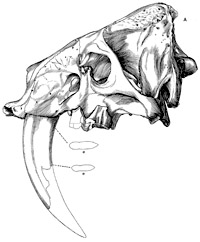Museum, University of Nebraska State

Bulletin of the University of Nebraska State Museum (1924–2023)
Date of this Version
1932
Document Type
Article
Citation
BULLETIN 31 VOLUME I OCTOBER, 1932
Abstract
A slab of pale, reddish-brown sandstone, exhibiting the articulated skeletons of two oreodonts, has been placed on display in the west corridor on the first floor of Morrill Hall. Apparently, a female and well-grown young one lay down together and perished, perhaps from disease, or from chilling winds. They must have been buried quickly, for all of the bones are present, are in perfect condition, and are in articulation, especially in the old one. In the adult the articulation is complete from the ungual phalanges of the two forefeet to the terminal caudal, even though in the figure the skeleton is somewhat obscured in the pelvic region by the overlying hind quarters of the young animal. The left foreleg is hidden by the skull. The sternal ribs, as well as the ribs, are in place. The bones are firm, and of ivory whiteness, and show up well against the brownish sandstone. This fine specimen was found in the Gering formation (Lower Miocene) near Birdcage Gap, Morrill County, Nebraska, by the field parties operating there in September 1931, and was dug out later by Mr. and Mrs. C. Bertrand Schultz, students in the University of Nebraska, and assistants in the museum. By them it was later prepared for exhibition.
Included in
Entomology Commons, Geology Commons, Geomorphology Commons, Other Ecology and Evolutionary Biology Commons, Paleobiology Commons, Paleontology Commons, Sedimentology Commons


Comments
Copyright © Nebraska State Museum. Used by permission.